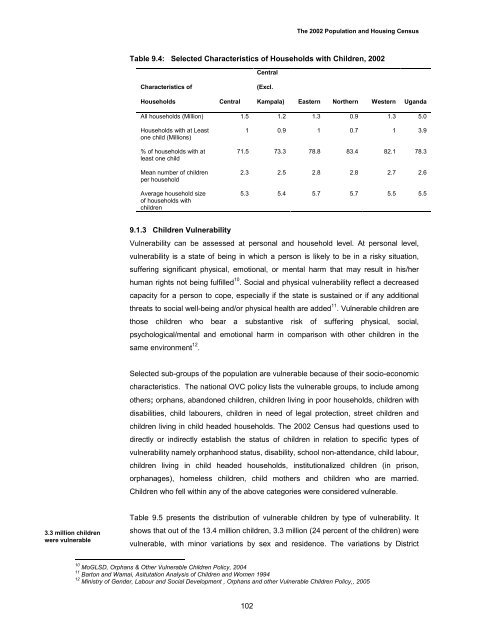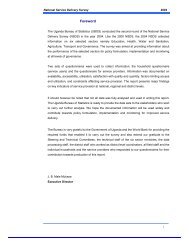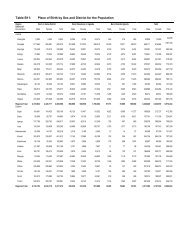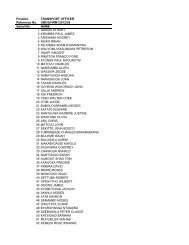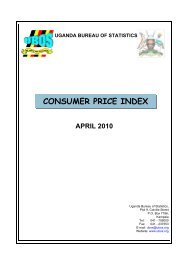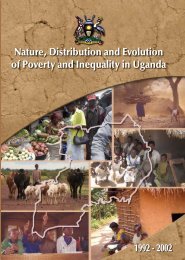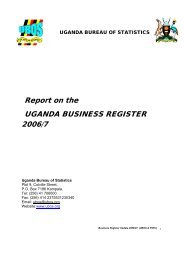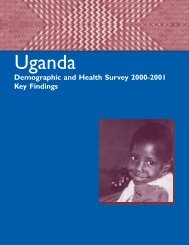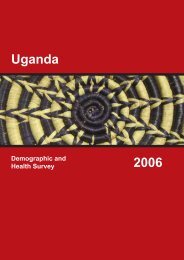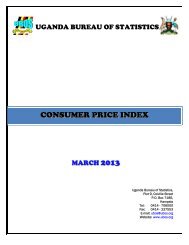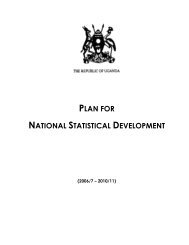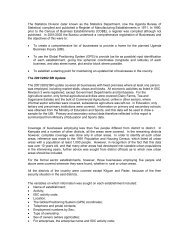Census Analytical Report - Uganda Bureau of Statistics
Census Analytical Report - Uganda Bureau of Statistics
Census Analytical Report - Uganda Bureau of Statistics
You also want an ePaper? Increase the reach of your titles
YUMPU automatically turns print PDFs into web optimized ePapers that Google loves.
The 2002 Population and Housing <strong>Census</strong>Table 9.4: Selected Characteristics <strong>of</strong> Households with Children, 2002CentralCharacteristics <strong>of</strong>HouseholdsCentral(Excl.Kampala) Eastern Northern Western <strong>Uganda</strong>All households (Million) 1.5 1.2 1.3 0.9 1.3 5.0Households with at Leastone child (Millions)% <strong>of</strong> households with atleast one childMean number <strong>of</strong> childrenper householdAverage household size<strong>of</strong> households withchildren1 0.9 1 0.7 1 3.971.5 73.3 78.8 83.4 82.1 78.32.3 2.5 2.8 2.8 2.7 2.65.3 5.4 5.7 5.7 5.5 5.59.1.3 Children VulnerabilityVulnerability can be assessed at personal and household level. At personal level,vulnerability is a state <strong>of</strong> being in which a person is likely to be in a risky situation,suffering significant physical, emotional, or mental harm that may result in his/herhuman rights not being fulfilled 10 . Social and physical vulnerability reflect a decreasedcapacity for a person to cope, especially if the state is sustained or if any additionalthreats to social well-being and/or physical health are added 11 . Vulnerable children arethose children who bear a substantive risk <strong>of</strong> suffering physical, social,psychological/mental and emotional harm in comparison with other children in thesame environment 12 .Selected sub-groups <strong>of</strong> the population are vulnerable because <strong>of</strong> their socio-economiccharacteristics. The national OVC policy lists the vulnerable groups, to include amongothers; orphans, abandoned children, children living in poor households, children withdisabilities, child labourers, children in need <strong>of</strong> legal protection, street children andchildren living in child headed households. The 2002 <strong>Census</strong> had questions used todirectly or indirectly establish the status <strong>of</strong> children in relation to specific types <strong>of</strong>vulnerability namely orphanhood status, disability, school non-attendance, child labour,children living in child headed households, institutionalized children (in prison,orphanages), homeless children, child mothers and children who are married.Children who fell within any <strong>of</strong> the above categories were considered vulnerable.3.3 million childrenwere vulnerableTable 9.5 presents the distribution <strong>of</strong> vulnerable children by type <strong>of</strong> vulnerability. Itshows that out <strong>of</strong> the 13.4 million children, 3.3 million (24 percent <strong>of</strong> the children) werevulnerable, with minor variations by sex and residence. The variations by District10 MoGLSD, Orphans & Other Vulnerable Children Policy, 200411 Barton and Wamai, Asitutation Analysis <strong>of</strong> Children and Women 199412 Ministry <strong>of</strong> Gender, Labour and Social Development , Orphans and other Vulnerable Children Policy,, 2005102


